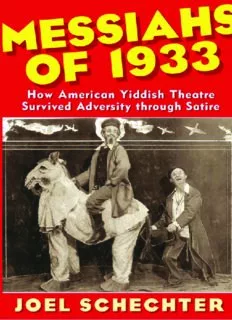
Messiahs of 1933: How American Yiddish Theatre Survived Adversity through Satire PDF
Preview Messiahs of 1933: How American Yiddish Theatre Survived Adversity through Satire
Messiahs of 1933 Messiahs of 1933 How American Yiddish Theatre Survived Adversity Through Satire Joel Schechter TEMPLE UNIVERSITY PRESS Philadelphia COVER ILLUSTRATION: The Wonder Horse with Litvak (Isidore Meltzer) on horse (Jack Goldman and Harry Bender) and unidentifi ed actor in We Live and Laugh, New York, 1936. Courtesy of the National Archives. TEMPLE UNIVERSITY PRESS 1601 North Broad Street Philadelphia PA 19122 www.temple.edu/tempress Copyright © 2008 by Temple University All rights reserved Published 2008 Printed in the United States of America The paper used in this publication meets the requirements of the American National Standard for Information Sciences—Permanence of Paper for Printed Library Materials, ANSI Z39.48-1992 Library of Congress Cataloging-in-Publication Data Schechter, Joel, 1947– Messiahs of 1933 : how American Yiddish theatre survived adversity through satire / Joel Schechter. p. cm. Includes bibliographical references and index. ISBN-13: 978-1-59213-872-2 (cloth : alk. paper) ISBN-10: 1-59213-872-1 (cloth : alk. paper) 1. Theater, Yiddish—United States—History. 2. Satire, Yiddish—United States—History and criticism. 3. Yiddish drama—United States—History and criticism. 4. Jewish actors— United States. I. Title. PN3035.S32 2008 792.089'92407—dc22 2007036744 2 4 6 8 9 7 5 3 1 Contents 1 Messiahs of 1933: How Playwright Moishe Nadir and Artef Led America Out of the Great Depression to a Future of Full Employment, Justice, and Yiddish Satire for All 1 2 Nadir’s Rivington Street: The Lower East Side Arises 37 3 Prayer Boxes as Precious as Diamonds: How Soviet Yiddish Satire Fared in America 57 4 The Federal Theatre Project in Yiddish: “The Society of the Sorely Perplexed” Takes the Stage 71 5 The Messiah of 1936: It Can’t Happen Here in Yiddish 105 6 Pinski’s Prelude to a Golden Age: The Tailor Becomes a Storekeeper 121 7 Menasha Skulnik Becomes a Bridegroom: Popular Yiddish Theatre Reconsidered 141 8 Prosperity’s Crisis on Stage: The Yiddish Puppetry of Maud and Cutler 157 9 Leo Fuchs, Yiddish Vaudevillian in “Trouble” 177 vi / Contents 10 Yetta Zwerling’s Comic Dybbuk 193 11 Menachem Mendel’s False Profi ts: Sholem Aleichem and the Communists 203 12 The Anti-Milkhome Zamlung of 1937: The Yiddish Anti-War Catalogue Reconsidered 221 13 Conclusion: Still Waiting for the Messiah 231 Appendix 239 Acknowledgments 245 Notes 247 Bibliography 279 Index 287 Messiahs of 1933 1 Messiahs of 1933 How Playwright Moishe Nadir and Artef Led America Out of the Great Depression to a Future of Full Employment, Justice, and Yiddish Satire for All O ne of the most radical cultural events in America could have taken place during the Great Depression, if everyone in the country spoke Yiddish: the public would have been able to welcome a Yiddish-speaking messiah who arrived in New York. With thirteen to fourteen million Americans unemployed, thousands of banks closed permanently, and breadlines everywhere, the nation needed a messiah. Not one, but two saviors arrived in New York and spoke the language of East European Jews in May of 1933. They could be seen in the company of actors at the Yiddish theatre collective Artef (Arbeter Teater Farband, or Worker’s Theatrical Alli- ance), when it staged Moishe Nadir’s play, Messiah in America.1 Nadir’s stage play begins with a comic portrait of theatre pro- ducers, and extends its satire to messianism. Broadway producer Menachem Yosef and his assistant Jack the Bluffer announce that a Yiddish-speaking messiah has arrived, and can be seen in their the- atre for a price. Menachem knows his messiah is an impostor, but the public welcomes the savior, much to the producer’s delight. The 1933 producers of Nadir’s play were messianic too. Artef’s actors, their director, and Nadir took upon themselves the tasks of a messiah, inaugurating in artistic form their visions of social justice, peace, and redistributed wealth. Their Yiddish-language
Description: